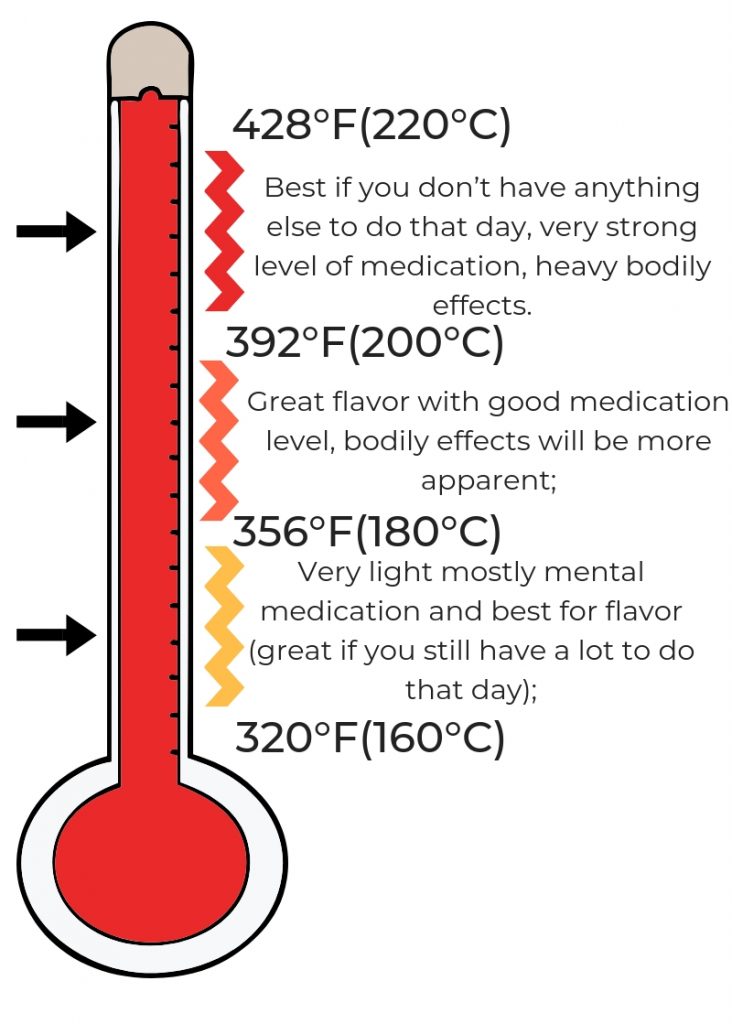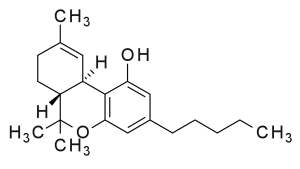Choosing the best temperature to vape weed is one of the most unclear and controversial topics in dry herb vaping.
It turns out, there is no single best temperature to vape weed.
The best temperature to vape your herb is fully dependent on what effects you’re looking for, but it oscillates between 320°F(160°C) and 446°F(230°C).
And in today’s post, I’m going to show you exactly what temperature is best for achieving your desired effects.

You will learn that changes in your vaporizer temperature have the potential to change the chemical structure and therefore the medical effects and taste of your marijuana vapor.
Get started below with our simple quick-guide:
- 320°F(160°C) – 356°F(180°C): Very light mostly mental medication and best for flavor (great if you still havee a lot to do that day);
- 356°F(180°C) – 392°F(200°C): Great flavor with good medication level, bodily effects will be more apparent;
- 392°F(200°C) – 446°F(230°C): Best if you don’t have anything else to do that day, very strong level of medication, heavy bodily effects.
Vaping cannabis has exploded in popularity. This modern alternative to smoking has gained traction as a potentially healthier option. The lack of combustion and carcinogenic substances makes vaping easier on the lungs. Plus, lower temperatures help to preserve the complex flavour of each strain. In contrast, smoking exposes the herb to violently high temperatures. Whether bud is burned with a basic flint-and-steel lighter or a blowtorch, it’s still getting burnt.
Modern vaporization technology allows cannabis lovers to vape their bud at a range of temperatures. Not only does this level of control make vaping easier on the pulmonary system, but it also allows users to customise every single hit. This groundbreaking innovation has changed the way people enjoy cannabis, unlocking an ability to target specific molecules, tastes, and effects.
WHY VAPORIZER TEMPERATURE MATTERS FOR CANNABIS
The cannabis plant is an organic chemical factory. Its flowers produce small, mushroom-shaped outgrowths called trichomes. These tiny structures pump out resin loaded with psychoactive and medicinal molecules. Among this repertoire are over 100 cannabinoids, more than 100 terpenes, and numerous flavonoids. By modifying vaporization temperature, cannabis users can optimise the concentration of specific molecules in each hit.
Every cultivar contains varying levels of cannabinoids and terpenes. THC—one of the most common cannabinoids—provides a psychotropic high and a long list of therapeutic qualities. In contrast, CBD offers powerful therapeutic qualities without any psychotropic effect. Most modern strains offer high levels of THC. However, breeders have recently developed strains containing high levels of CBD, or strains with a 1:1 ratio of the two cannabinoids.
Science is starting to pay more attention to other major and minor cannabinoids. Research has already confirmed that CBG (cannabigerol) offers painkilling and anti-inflammatory effects. THCV (tetrahydrocannabivarin) can help to suppress the effects of THC and may combat pain and inflammation. CBC (cannabichromene) appears to reduce swelling and preserve mammalian brain cells. This is just the tip of the iceberg! As the science progresses, more data will surely begin to surface.
CANNABIS BOILING POINT TEMPERATURES

And let’s not forget about our friends, the terpenes. These aromatic molecules can be found all throughout the plant kingdom. Terpenes provide the signature scents and tastes of each cannabis cultivar, but their function isn’t limited to sensory pleasure. These molecules offer a host of therapeutic effects and are even believed to synergise[1]with cannabinoids to produce more pronounced medicinal effects. Myrcene is one of the most abundant terpenes within all cannabis cultivars. The chemical provides tastes of earthiness and cloves, and is known for its relaxing and sedating effects.
Myrcene enhances the anti-inflammatory effects of CBD, as well as the muscle-relaxing effects of THC. Caryophyllene is another major terpene found in cannabis flowers, contributing tastes of pepper and spice. Also recognised as a “dietary cannabinoid”, the terpene is capable of producing anti-inflammatory effects[2] by binding to CB2 receptors of the endocannabinoid system.
Cannabis users often select strains based on their cannabinoid and terpene concentration. Recreational users may choose a high-THC strain for maximal psychoactive effects. They might also look for a variety high in myrcene to ensure a sedating high. By comparison, medicinal users might opt for a strain high in CBD, with a good caryophyllene profile to boost the anti-inflammatory effects.
By altering vaping temperature, cannabis users can ensure they receive maximum levels of the desired constituents. Plus, playing around with temperature settings can make each hit more pleasant. Users can set their devices to low temperatures while still getting all of the desired molecules. This allows for smooth hits loaded with cannabinoids, that are also less harsh on the throat and lungs.Below, we’ll discuss how to use temperature settings to zero-in on certain cannabis chemicals.
The Chemical Structure and Pharmacological Effects of Cannabis Explained

If there’s one cannabinoid in marijuana that everyone seems to know it must be THC. Marijuana often gets equalized with THC.
What most people don’t know, however, is that the Cannabis plant contains over 70 known cannabinoids and THC is just one of them.
Why does this matter?
Each and every cannabinoid has its own chemical structure and pharmacological effects. On top of the 70-plus known cannabinoids, the Cannabis plant contains many other types of compounds like:
- 120 different terpenoids, and;
- 23 different flavonoids,
Each having its own chemical structure and pharmacological effects.
To complicate things further, studies like this one suggest that all of the cannabinoids, terpenoids, and flavonoids in Cannabis influence each other and their pharmacological effects, enhancing each other’s effects and mitigating each other’s side-effects.
Cannabis really is a ‘synergistic shotgun’, where hundreds (probably thousands) of different compounds work together to produce a particular pharmacological effect.
In short:
Don’t reduce Cannabis to one single cannabinoid (THC). The Cannabis plant is a very complex plant containing thousands of different compounds that all have their unique characteristics and effects.
We always want to simplify things, but simplifying the Cannabis plant to THC is going to hinder you in finding your best vaping temperature as you’ll learn now.

This will vary from strain to strain, but each strain usually has some beat temperature whee it gets most potent. I would like to request you to please create such a list and share as then it would become a lot more easier to try new strains.
I’m a beginner with medical marijuana and had a lot of questions. I came across your site in my quest for answers. I found the right place. Many thanks for making this information available for us novices. I’ve bookmarked your site for future reference and will send a few friends your way.